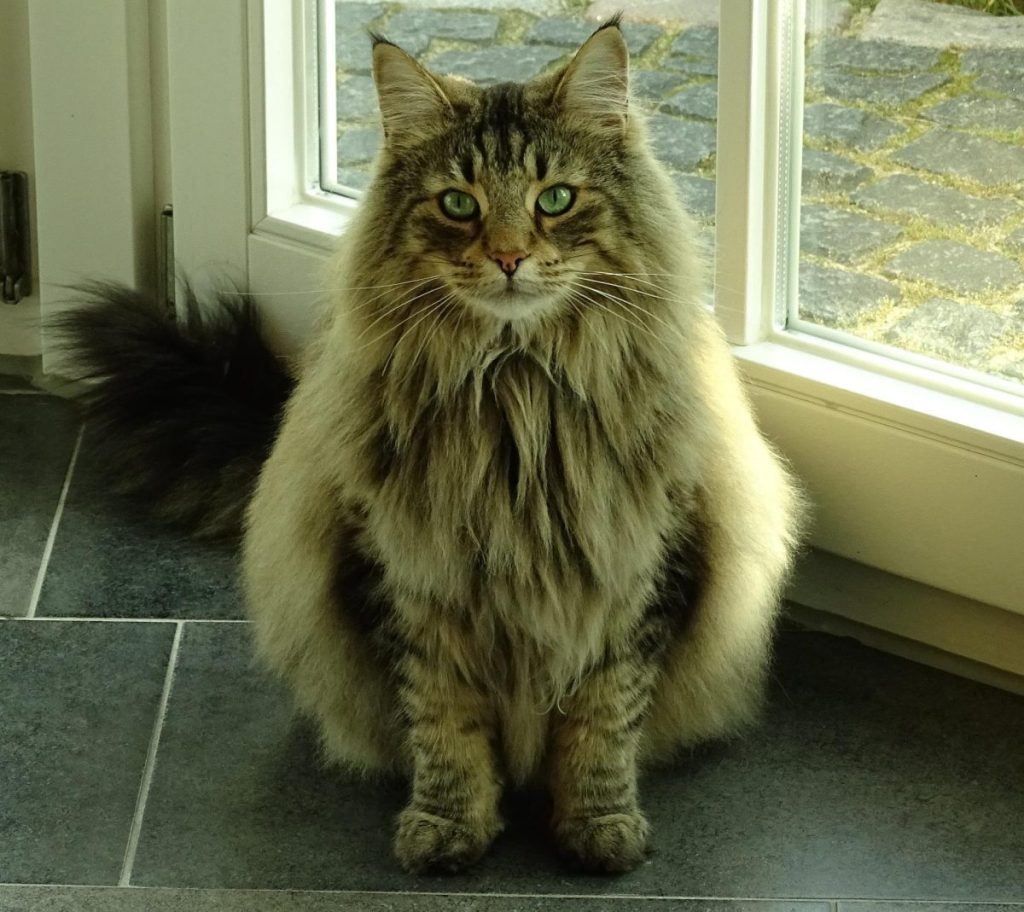
Everything You Need to Know About the Norwegian Forest Cat
Mar 1 2024.
The Norwegian Forest Cat is beloved for their beautiful, thick coats, large sizes, and even larger personalities! Referred to as skogkatt (meaning ‘forest cat’) in Norway, these gorgeous kitties have a fascinating feline history that goes all the way back to the Vikings! Curious to learn more about the Norwegian Forest Cat’s background, personality, and care? Read on for Cat in a Flat’s comprehensive guide to the Norwegian Forest Cat!
Table of contents
Where does the Norwegian Forest Cat come from?
Where did the Norwegian Forest Cat come from? Well, the answer is in the name. That’s right, this gorgeous breed originally comes from Norway. Long before they were domesticated and made their way into our homes (and hearts), the skogkatt roamed the Scandinavian forests. Legend has it that these kitties are the descendants of warrior cats from Norse mythology, and inherited their wild and rugged appearance from their ancestors of yore. These sturdy physical attributes made them ideal for ship travel, and the Norwegian Forest Cat eventually joined Vikings on sea voyages as mousers.
One particularly fascinating fact about this breed’s origins is that they evolved naturally. For a long time, Norwegian Forest Cats were not bred by humans but rather developed their traits through natural selection. However, in the early 20th century these felines were at risk of dying out. This was when breeders stepped in, working hard to save the Norwegian Forest Cat breed!

Norwegian cat appearance
- Look: Large and muscular with tufted ears and long, bushy tails.
- Lifespan: 12-15 years. Norwegian cats don’t reach full adult size until 3-4 years of age. Hence, it’s often said that these furry friends can stay kittens long into adulthood!
- Weight: On average, the Norwegian Forest Cat will weigh around 5.8 kilos (12.8 pounds). Some kitties can weigh up to 10 kilos (22 pounds), though this is rare.
- Coat: Semi-long. These kitties have a two-layer coat consisting of a soft topcoat and a dense undercoat. In colder weather, Norwegian Forest cats will ‘grow’ a ruff around the neck to further protect them from freezing in the winter.
- Colors: These felines can come in any color and with any type of markings (yes, even calico or tabby) with the exception of chocolate, lilac, or Siamese markings.
Do Norwegian Forest Cats have nice personalities?
What type of personalities do Norwegian Forest Cats have? This cat breed is social and affectionate, which makes them a great option for first time paw parents. They are truly gentle giants and like spending time with their humans. While a Norwegian Forest Cat will enjoy curling up next to you, they aren’t usually lap-cats as they’re prone to overheating. They are also highly active and intelligent and require a lot of daily enrichment and playtime.
It’s important to note that Norwegian cats are strong natural hunters. This means that they aren’t the best choice if you have other small pets such as a bird, rabbit, or guinea pig.
How to care for a Norwegian Forest Cat
Grooming
Because of their long, thick coats, these fur friends need to be brushed daily, especially during periods where they are shedding their fur. Read up on how to groom a long-haired cat and how to keep Mr Whiskers from overheating in the hot summer months.
Activity
While Norwegian Forest Cats are a laid-back breed, they are also very active. You will need to create a cat-friendly household with plenty of enrichment for your fur friend. These felines thrive with plenty of stimulated hunting and interactive play. You’ll need to play with Mr Whiskers multiple times a day to keep them happy and healthy.
Living
Because of their size, Norwegian cats are not ideal for apartment living. These kitties need a lot of space to climb and jump, as well as safe access to the outdoors. By nature, they are outdoor felines, so your fur friend will want to spend time outside. If you are away from home a lot, you may need to hire a cat sitter to provide at-home day care for your fur friend. If this isn’t an option, then you should reconsider bringing a Norwegian cat into your life.
Feeding
Because of their robust constitution, your Norwegian Forest Cat’s dietary requirements shouldn’t be too different from that of most other felines. Choose a mix of high-quality wet and dry foods. Aim to feed your cat twice a day—in the morning and in the evening—and avoid grazing (leaving food out all day for your fur friend to nibble from). Like any breed, a Norwegian Forest Cat can become overweight if left to eat whenever they want.
Where do I get a Norwegian cat?
If you’re considering bringing a Norwegian cat into your life, you should know that these are an expensive, high-maintenance breed. They can cost upwards of a $1,000 and are costly to keep as well. These felines are also only available from breeders with a proven pedigree.
If possible, we would recommend adopting instead. There are so many kitties out there waiting for good homes, and you can find your purrfect furry match at a shelter too! However, if you’re set on getting a Norwegian Forest Cat, make sure the cat has a pedigree and that you source them from an ethical breeder and not a kitty mill.
Interested in different breeds and their characteristics? Check out our blog post on the most popular cat breeds. And if you can’t get enough of felines in general (who can?) you’ll love this blog post answering common cat questions!
- #catinaflat
- Cat Care
- large cat breeds
- norse cat
- Norwegian cat care
- Norwegian forest cat
